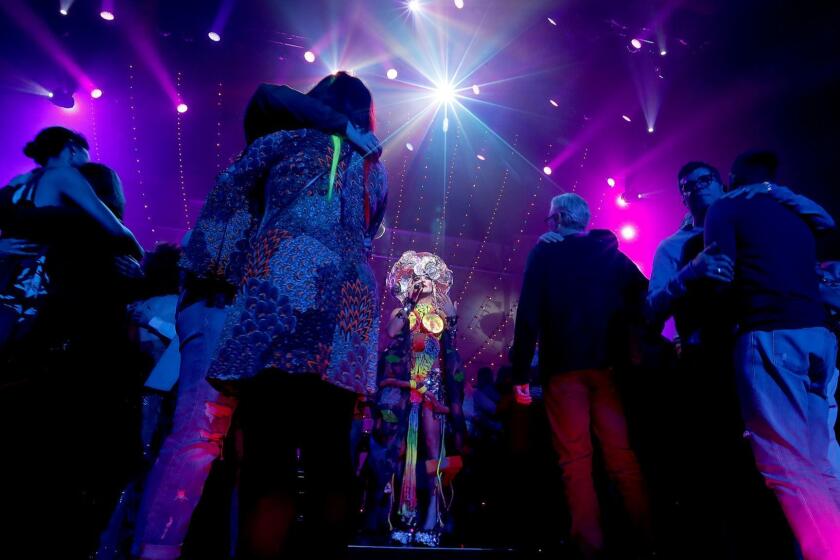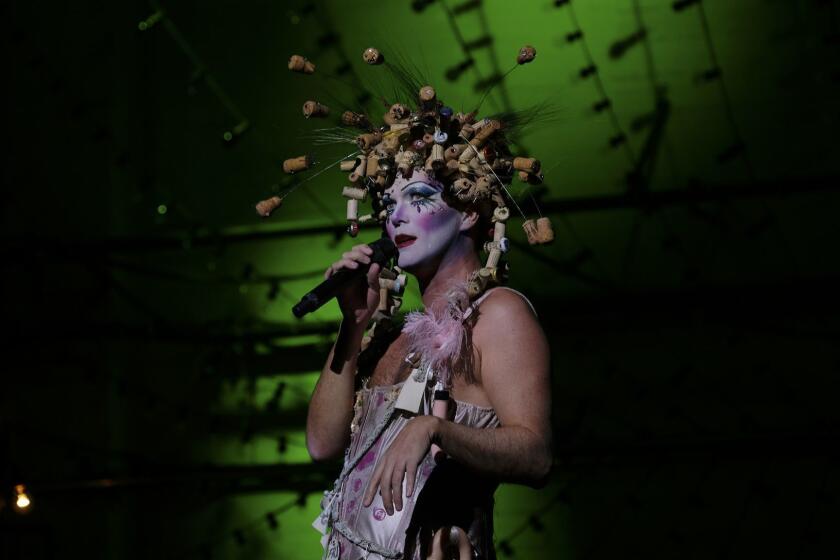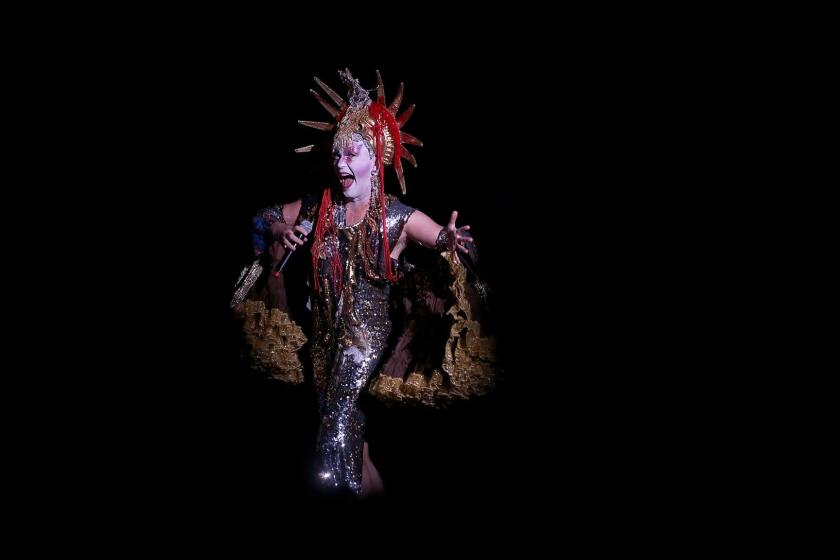Taylor Mac’s documentary is a front row seat to a very queer 24 decades of pop music
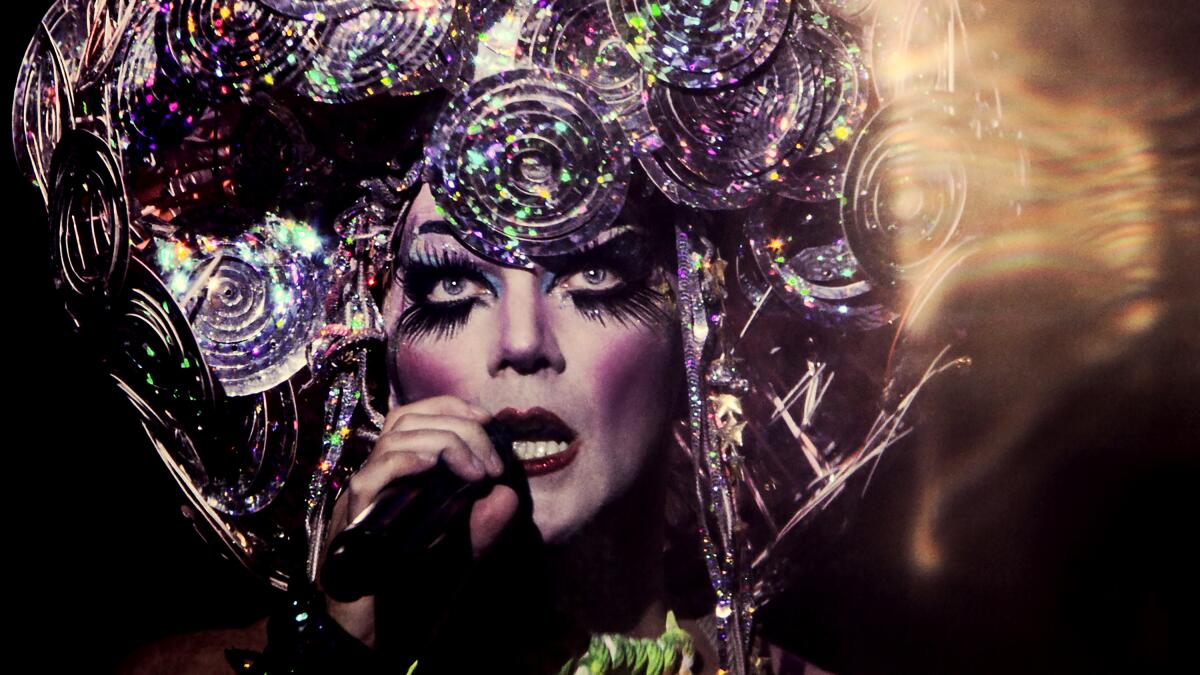
- Share via
There’s a lot that shimmers in “Taylor Mac’s 24-Decade History of Popular Music,” a new HBO documentary that debuts Tuesday. There are the sensational handcrafted costumes — festooned with fake hot dogs, gay porn, maribou — made by the designer Machine Dazzle. There’s Anastasia Durasova’s makeup that makes a face look like that of a melting high-glam harlequin.
But what really shines is queerness. Produced and directed by the Oscar-winning filmmakers Rob Epstein and Jeffrey Friedman, the film is an ultra-condensed look at the very queer immersive theater piece by Taylor Mac that took place over 24 hours in 2016 in front of an audience at St. Ann’s Warehouse, a performance venue in Brooklyn.
Culled from 500 hours of filmed concert footage, the film begins on Oct. 8 at noon when Mac transported the audience to 1776 with a racy interpretation of “Yankee Doodle Dandy” and ends 24 hours later with Mac alone on stage, voice reduced to a fatigued rasp, singing a song called “When All the Artists Leave or Die.”
In between, Mac and an ensemble of performers and musicians put queer spins on unfamiliar Revolutionary War ballads, racist minstrel songs, modern pop anthems and other musical styles, engaging the audience throughout in sometimes deeply intimate ways. (You’ll never hear Laura Branigan’s “Gloria” the same again.)
Taylor Mac’s “A 24-Decade History of Popular Music” is a necessary and great American epic for our time.
Mac performed all 24 hours consecutively just the once but later toured the show, breaking it down into half and quarter segments; in 2018, a four-part version played in Los Angeles at the Theatre at Ace Hotel. Mark Swed, the Times’ classical music critic, said the show was “a necessary and great American epic for our time.”
In an email, Epstein said Mac’s synthesis of art and social commentary “feels so right for this moment.”
“It’s a marker of a pre-covid, pre-Trump cultural moment, but it also transcends any moment, and that’s what great art can do,” wrote Epstein, whose credits include the Oscar-winning documentaries “The Times of Harvey Milk” and “Common Threads: Stories From the Quilt,” the latter being a collaboration with Friedman.
Mac isn’t done mining the queer past: The performer’s next project is “Bark of Millions,” a four-hour show of original songs inspired by queer historical figures, set to make its West Coast premiere next year in Berkeley.
In a recent Zoom call from Provincetown, Mass., Mac spoke about making the film and finding your tribe. The conversation has been edited and condensed.
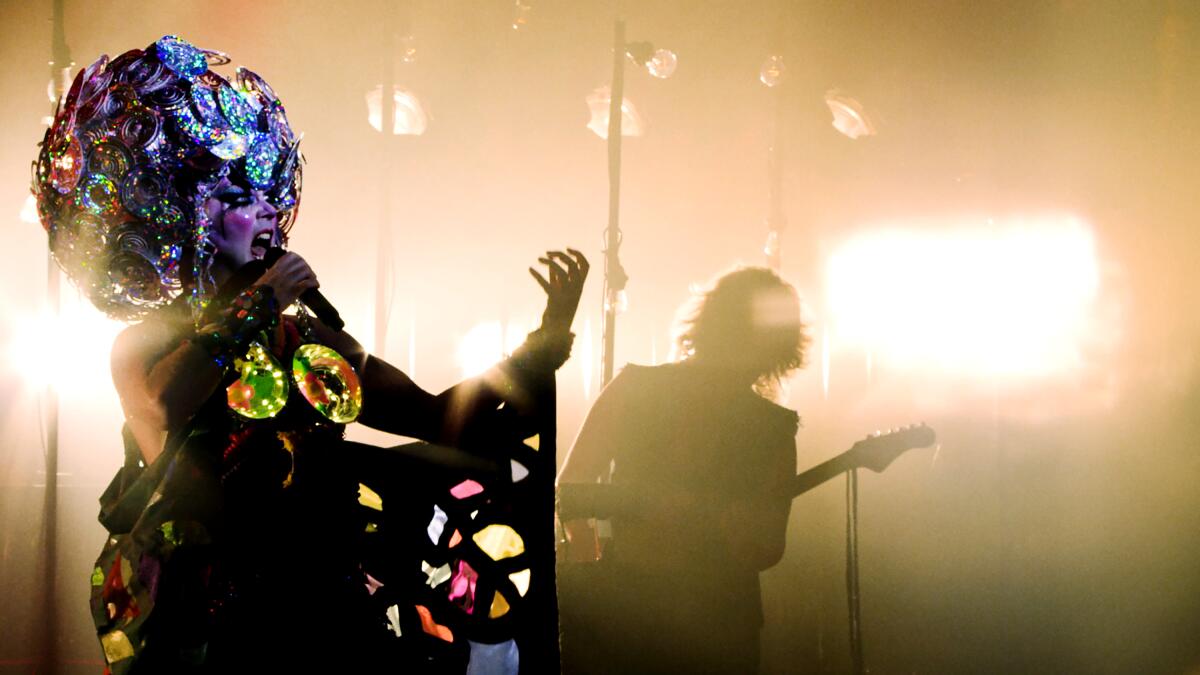
Looking back at the 24-hour show, are there things you wish you had or hadn’t done?
I’ve been looking at the footage on a daily basis, so I haven’t had much distance from it to regret or want to change things. But the show was always very ephemeral.
What I’ve come to understand about film, which is new to me, is that it’s also ephemeral. Watching the footage five years ago is very different from watching the footage today. I’m a different person, I’m older, the world has changed a lot. I’ve been working with my therapist on this [laughs], but I can see the foibles of the film and my performance and things I might want to change as entry points towards my humanity. We can’t change history, but we can change how we deal with it, look at it, feel about it.
How do you feel about the show getting a wide reach on HBO?
Rob and Jeff have this lineage of queer cinema, and I don’t think the stage show would exist without their films. Watching their films on PBS was my only access to queerness. They formed a lot of my understanding of the world. I feel so honored to be part of their body of work.
Often when queer work is given a larger platform, it flattens it. It makes it feel like what it’s trying to do is win at capitalism. That’s not what happens here. It feels very much authentically our show. It’s not the show, it’s a film, with its own art and beauty to it that the show could never have had. I don’t feel the film is saying, you missed it, too bad you weren’t there. It’s saying, here’s a really close seat.
The professors and university mandarins having lunch at an elegant UCLA campus restaurant the other day had no idea that seated inconspicuously among them was a cultural revolutionary.
Do you have a memory of the Los Angeles performances?
I remember at first it was challenging. People arrived so late. The way that the theater had initially set it up, the rich people all got the front seats and they were the ones that came latest. The first show was rows and rows and rows that were empty at the very beginning of the performance. An hour into the show they were trickling in. We had to start the show earlier than normal because of traffic and parking and valets.
But what I noticed by the end of the first show was the room had gathered. We’d been through something together. At about hour three it started getting profound, and the rest of the run was really moving. That energy shifted. People started prioritizing the art instead of what they wanted to do in order to get to the next thing they wanted in life. They started being with each other more. They were wonderful shows once we spent three hours warming them up.
I was struck by how good your voice was by the time you got to “Soliloquy” from the 1945 musical “Carousel.” How did you protect your voice during the show?
I worked with this wonderful voice teacher, Barbara Maier Gustern, who was kind of the voice teacher of all downtown artists. She created with me a whole system of how I could ease up on certain vocal things. Normally when people start a song there will be a catch in the voice that explodes out. That’s very tiring on your vocal cords. We worked on it for years so that I wouldn’t have to think about it when I was on stage. It would just happen.
But the point was to vocally fall apart. That’s what I find moving about the film, that you really do hear my voice just ravaged by the end.
In the film you also talk about growing up in Stockton and finding your tribe. Who were those people?
I had these friends — Marcy Coburn, Kat Wentworth, John Robertson — that were queers. We weren’t out to each other in high school, but by the end of high school we all came out to each other. They were the people that got me through that environment and have stayed with me since. I have a real clarity on chosen family, something that can enrich your life in a way that a biological family sometimes can’t.
You give the last word in the show, before you’re alone on stage, to lesbian singers of the ‘90s. Why?
The whole show is this metaphor for the AIDS epidemic and for communities building themselves as a result of being torn apart. When we get to the decades where I’m actually alive in history, the show becomes much more personal. A lot of the gay men who would have been my mentors or lovers or learned from, they weren’t there.
My lived experience was that lesbians knew that was happening and took me under their wing. It came at a time when a lot of lesbians were wondering how to create a world where men weren’t the center of the story. It was a real sacrifice, in a way, because they saw this need and they did it anyway.
I wanted to acknowledge that and say: I see what you did, and it was pretty incredible.
‘Taylor Mac's 24-Decade History of Popular Music’
Where: Max
When: Anytime, starting June 27
Rating: TV-14 (may be unsuitable for children younger than 14)
More to Read
The complete guide to home viewing
Get Screen Gab for everything about the TV shows and streaming movies everyone’s talking about.
You may occasionally receive promotional content from the Los Angeles Times.
